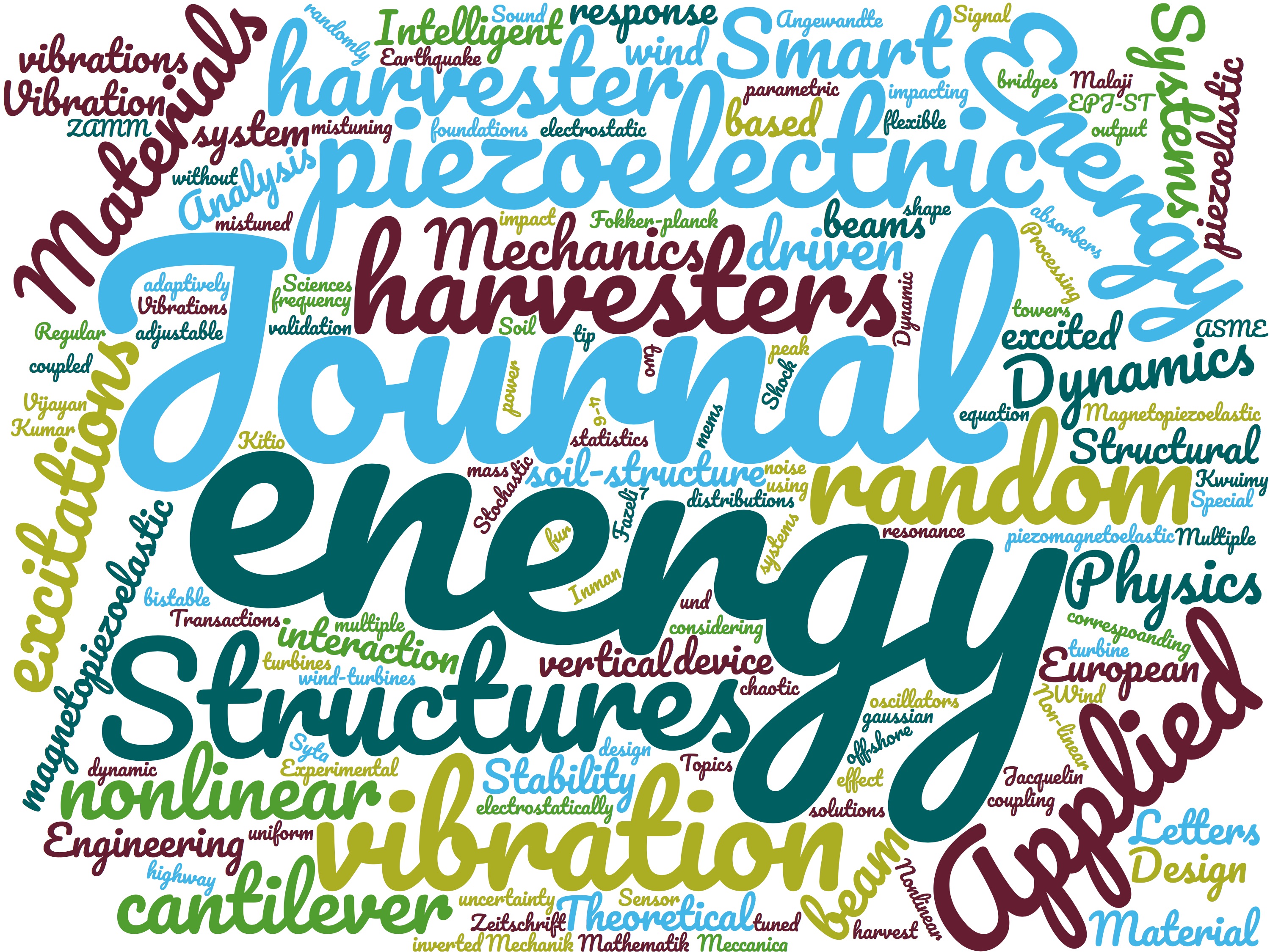
Figure: A word-cloud from the title of the journal papers
Professor Adhikari's research works in this field contribute to the following sub areas:
A brief description of the research topics and some key journal publications are given below. Research by other colleagues can be seen in the Google Scholar page energy harvesting.
E.1. Nonlinear vibration energy harvesting
The harvesting of ambient vibration energy for use in powering low energy electronic devices has formed the focus of much. Of the published results that focus on the piezoelectric effect as the transduction method, almost all have focused on harvesting using cantilever beams and on single-frequency ambient energy, i.e. resonance-based energy harvesting. Such devices have to be tuned to the excitation and may not be robust to variations in the excitation frequency. One way to 'expand' the efficiency of energy harvesting over a broader frequency range is to consider nonlinear vibration in the energy harvesters. In some other situations, nonlinear energy harvesters arise naturally such as systems undergoing impact or systems operating within a different force field such as magnetic or electrostatic. Our research develops experimental and theoretical methods for novel nonlinear energy harvester concepts.
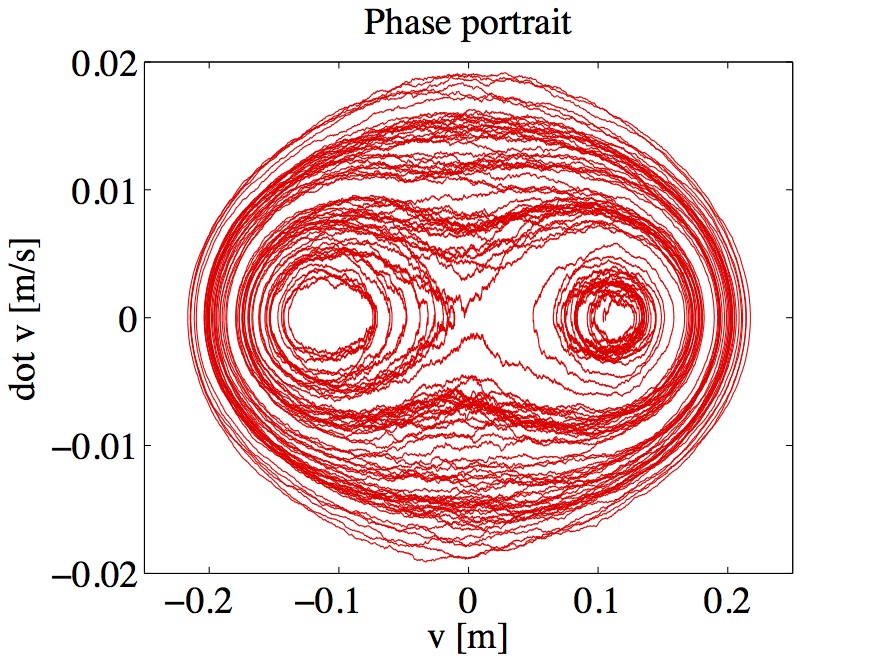 Voltage phase potrait of a nonlinear energy harvester Voltage phase potrait of a nonlinear energy harvester |
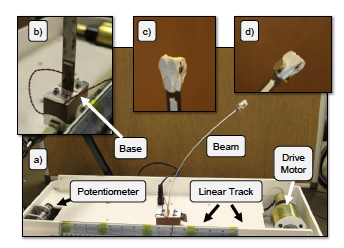 The experimental rig of a nonlinear energy harvester based on an inverted cantelever The experimental rig of a nonlinear energy harvester based on an inverted cantelever |
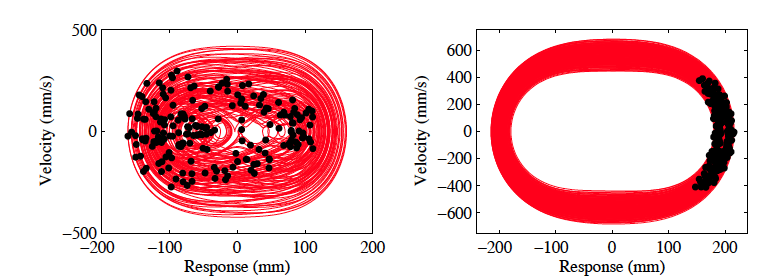 Voltage phase potraits Voltage phase potraits |
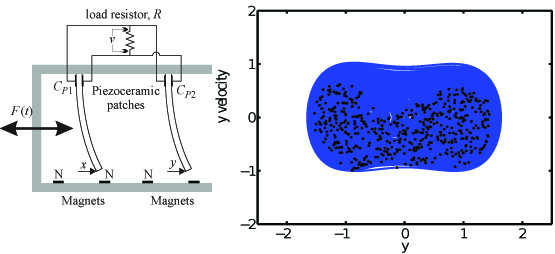 Coupled magnetopiezoelastic energy harvesters Coupled magnetopiezoelastic energy harvesters |
Key Journal Publications
- Madinei, H., Khodaparast, H. H., Friswell, M. I. and Adhikari, S., “Stochastic nonlinear analysis of vibration based MEMS piezoelectric harvesters,” Energy, in press.
- Madinei, H., Khodaparast, H. H., Adhikari, S., and Friswell, M. I., “Design of MEMS piezoelectric harvesters with electrostatically adjustable resonance frequency,” Mechanical Systems and Signal Processing, Vol. 81, No. 12, 2016, pp. 360-374.
- Syta, A., Litak, G., Friswell, M. I., and Adhikari, S., “Multiple solutions and corresponding power output of a nonlinear bistable piezoelectric energy harvester,” European Physical Journal B, Vol. 89, No. 4, 2016, pp. 99:1-7.
- Malaji, P. V., Ali, S. F., Adhikari, S., and Friswell, M. I., “Analysis of harvesting energy from mistuned multiple harvesters with and without coupling,” Procedia Engineering, Vol. 144, No. 6, 2016, pp. 621-628.
- Litak, G., Friswell, M. I., and Adhikari, S., “Regular and chaotic vibration in a piezoelectric energy harvester,” Meccanica, Vol. 51, No. 5, 2016, pp. 1017-1025.
- Madinei, H., Khodaparast, H. H., Adhikari, S., Friswell, M. I., and Fazeli, M., “An adaptively tuned piezoelectric MEMS vibration energy harvester using an electrostatic device,” European Physical Journal Special Topics (EPJ-ST), Vol. 224, No. 14, 2015, pp. 2703-2717.
- Friswell, M. I., Bilgen, O., Ali, S. F., Litak, G., and Adhikari, S., “The effect of noise on the response of a vertical cantilever beam energy harvester,” Zeitschrift fur Angewandte Mathematik und Mechanik (ZAMM), Vol. 95, No. 5, 2015, pp. 433-443.
- Vijayan, K., Friswell, M. I., Khodaparast, H. H., and Adhikari, S., “Non-linear energy harvesting from coupled impacting beams,” International Journal of Mechanical Sciences,Vol. 96-97, No. 6, 2015, pp. 132-142.
- Borowiec, B., Litak, G., Friswell, M. I., and Adhikari, S., “Energy harvesting in a nonlinear cantilever piezoelastic beam system excited by random vertical vibrations,” International Journal of Structural Stability and Dynamics, Vol. 14, No. 8, 2014, pp. 1440018:1-13.
- Ali, S. F. and Adhikari, S., “Energy harvesting dynamic vibration absorbers,” Transactions of ASME, Journal of Applied Mechanics, Vol. 80, No. 4, 2013, pp. 041004:1-9.
- Friswell, M. I., Ali, S. F., Adhikari, S., Lees, A. W., Bilgen, O., and Litak, G., “Nonlinear piezoelectric vibration energy harvesting from an inverted cantilever beam with tip mass,” Journal of Intelligent Material Systems and Structures, Vol. 23, No. 3, 2012, pp. 1505-1521.
- Litak, G., Friswell, M. I., Kitio Kwuimy, C. A., Adhikari, S., and Borowiec, B., “Energy harvesting by two magnetopiezoelastic oscillators with mistuning,” Theoretical & Applied Mechanics Letters, Vol. 2, No. 4, 2012, pp. 043009.
- Ali, S. F., Friswell, M. I., and Adhikari, S., “Analysis of energy harvesters for highway bridges,” Journal of Intelligent Material Systems and Structures, Vol. 22, No. 16, 2011, pp. 1929-1938.
- Jacquelin, E., Adhikari, S., and Friswell, M. I., “Piezoelectric device for impact energy harvesting,” Smart Materials and Structures, Vol. 20, No. 10, 2011, pp. 105008:1-12.
- Friswell, M. I. and Adhikari, S., “Sensor shape design for piezoelectric cantilever beams to harvest vibration energy,” Journal of Applied Physics, Vol. 108, No. 1, 2010, pp. 014901:1-6.
E.2. Energy harvesting under uncertainty
Vibration-based energy harvesting systems using piezoelectric, electromagnetic and electrostatic devices have been the subject of intense research in the last decade leading to efficient capturing of small amounts of energy from vibrating structures which when converted into electrical energy can be used to power micro and nano-electronic devices, sensors and recharge batteries. Previous research has considered the problem of determining optimal system parameters for maximising the harvested energy. Most of the early works in this area focused on systems subjected to deterministic excitation, typically to harmonic excitation. An important factor to be considered in these cases is to rely on the system performance near resonance requiring the frequency of excitation to be close to system natural frequency. Even slight deviation of the applied ambient excitation from the resonant condition resulted in significant reduction in the harvested energy. This led to the consideration of energy harvesters which are effective over a wide range of frequencies and to the study of their performance subjected to broadband random excitation. The consideration of random excitation has also to do with the fact that in many practical situations the ambient excitation could per se be stochastic. The design of the harvester must account for this form of excitation. Using random vibration theory, we derived novel closed-form expressions for the mean power harvested by a piezoelectric based energy harvester attached to a vibrating structure subjected to base Gaussian white noise random excitation. Both linear and nonlinear systems are considered.
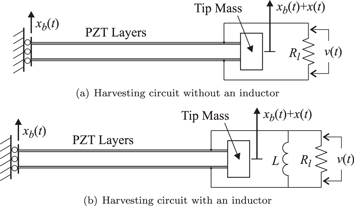 Schematic diagrams of cantelever piezoelectric energy harvesters with two different harvesting circuits Schematic diagrams of cantelever piezoelectric energy harvesters with two different harvesting circuits |
 Joint PDF and contour plot of the energy from a piezomagnetoelastic energy harvester Joint PDF and contour plot of the energy from a piezomagnetoelastic energy harvester |
Key Journal Publications
- Adhikari, S., Friswell, M. I., Litak, G., and Khodaparast, H. H., “Design and analysis of vibration energy harvesters based on peak response statistics,” Smart Materials and Structures, Vol. 25, No. 6, 2016, pp. 065009:1-16.
- Kumar, P., Narayanan, S., Friswell, M. I., and Adhikari, S., “Fokker-Planck equation analysis of randomly excited nonlinear energy harvester,” Journal of Sound and Vibration,Vol. 333, No. 7, 2014, pp. 2040-2053.
- Borowiec, B., Litak, G., Friswell, M. I., Ali, S. F., Adhikari, S., Lees, A. W., and Bilgen, O., “Energy harvesting in piezoelastic systems driven by random excitations,” International Journal of Structural Stability and Dynamics, Vol. 14, No. 1, 2013, pp. 1340006:1-11.
- Litak, G., Borowiec, B., Friswell, M. I., and Adhikari, S., “Energy harvesting in a magnetopiezoelastic system driven by random excitations with uniform and Gaussian distributions,” Journal of Theoretical and Applied Mechanics, Vol. 49, No. 3, 2011, pp. 757-764.
- Ali, S. F., Adhikari, S., Friswell, M. I., and Narayanan, S., “The analysis of piezomagnetoelastic energy harvesters under broadband random excitations,” Journal of Applied Physics, Vol. 109, No. 7, 2011, pp. 074904:1-8.
- Ali, S. F., Friswell, M. I., and Adhikari, S., “Piezoelectric energy harvesting with parametric uncertainty,” Smart Materials & Structures, Vol. 19, No. 10, 2010, pp. 105010:1-9.
- Litak, G., Friswell, M. I., and Adhikari, S., “Magnetopiezoelastic energy harvesting driven by random excitations,” Applied Physics Letters, Vol. 96, No. 21, 2010, pp. 214103.
- Adhikari, S., Friswell, M. I., and Inman, D. J., “Piezoelectric energy harvesting from broadband random vibrations,” Smart Materials & Structures, Vol. 18, No. 11, 2009, pp. 115005:1-7.
E.3. Dynamics of wind turbines
Wind energy would be essential for the sustainable development of UK (and the World in general) in the 21st century. It is expected to play a key role in the overall green energy production in this country. The accurate prediction of wind velocities is crucial for reliable estimates of the energy output of wind energy farms. Typically, long-term wind-velocity histories are available at the met office locations (roughly in 50-100 miles grids) at a certain height. The challenge is to predict wind velocities for the next 10 years at a wind-farm location (generally different from a met office location and at different `hub-heights'). Existing works can generally predict the mean wind velocities in a reliable manner. In this work novel methods have been developed to predict uncertainties associated with the mean wind velocities. Design and dynamic analysis of wind turbines are also considered. In particular, we develop a completely new reduced-order and experimentally validated design and analysis method for wind-turbines on flexible foundations.
 Schematic diagram of a wind turbine and our mathematical simplification Schematic diagram of a wind turbine and our mathematical simplification |
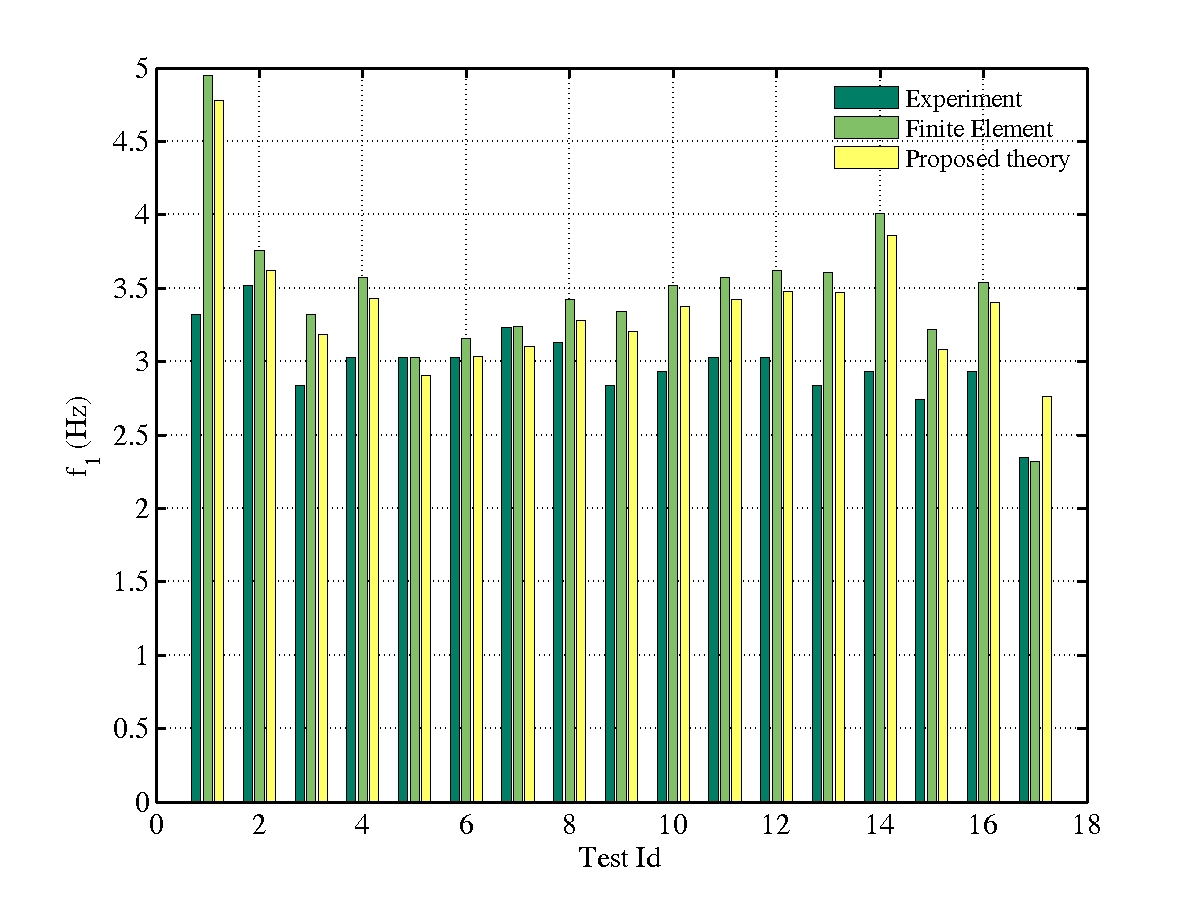 Comparison between experimentally observed natural frequencies and predictions from our new thoery Comparison between experimentally observed natural frequencies and predictions from our new thoery |
Reports
-
Adhikari, S.,
On the Application of ANOVA method for Wind Energy Predictions,
Report prepared for Garrad Hassan Ltd, March 2007.
-
Adhikari, S.,
Uncertainty Quantification in the Prediction of Wind Velocities,
Report prepared for Garrad Hassan Ltd, April 2006.
Key Journal Publications
- Adhikari, S. and Bhattacharya, S., “Dynamic analysis of wind turbine towers on flexible foundations,” Shock and Vibration, Vol. 19, No. 1, 2012, pp. 37-56.
- Adhikari, S. and Bhattacharya, S., “Vibrations of wind-turbines considering soil-structure interaction,” Wind and Structures, An International Journal, Vol. 14, No. 2, 2011, pp. 85-112.
- Bhattacharya, S. and Adhikari, S., “Experimental validation of soil-structure interaction of offshore wind turbines,” Soil Dynamics and Earthquake Engineering,Vol. 31, No. 4-6, 2011, pp. 805-816.
Home |
Research |
Publications |
Teaching |
Lectures |
Students and Post-docs |
Education & awards |
Professional activities |
Contact |
Departmental web page |
Downloads
This page was by Sondipon Adhikari
|


 Voltage phase potrait of a nonlinear energy harvester
Voltage phase potrait of a nonlinear energy harvester Coupled magnetopiezoelastic energy harvesters
Coupled magnetopiezoelastic energy harvesters Schematic diagrams of cantelever piezoelectric energy harvesters with two different harvesting circuits
Schematic diagrams of cantelever piezoelectric energy harvesters with two different harvesting circuits Joint PDF and contour plot of the energy from a piezomagnetoelastic energy harvester
Joint PDF and contour plot of the energy from a piezomagnetoelastic energy harvester  Schematic diagram of a wind turbine and our mathematical simplification
Schematic diagram of a wind turbine and our mathematical simplification Comparison between experimentally observed natural frequencies and predictions from our new thoery
Comparison between experimentally observed natural frequencies and predictions from our new thoery